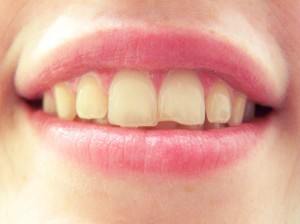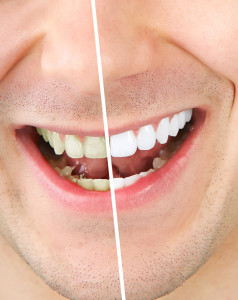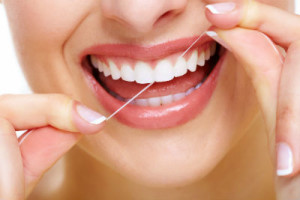It’s a sign of how effective Listerine television advertising has been — everyone has heard the word gingivitis. That’s because those TV commercials always say that the mouthwash helps prevent gingivitis. It’s a great word to scare people into buying Listerine because it sounds ominous, scary.
But if you asked anyone what gingivitis actually means, the percentage would be remarkably low. At EMA Dental, we like educated patients, so we’re going to give you a little primer on gingivitis.
And no, it’s not a dental condition that affects only red-haired people!
Gingivitis, the gums have it
“Gingivitis” sounds scary. Actually, its meaning is fairly benign — the term gingivitis simply means gum inflammation. And, just like your younger brother, plaque is the main irritant involved here. Plaque is the sticky film that forms on the teeth throughout the day consisting of bacteria, bacterial waste products, food residue, and saliva. This is an ongoing battle. When you brush and floss you remove the plaque. Then it starts to rebuild, only to be removed again when you brush.
“When you brush.” That’s key, because if you neglect your oral hygiene the plaque can develop beneath the gumline, where it is very irritating to your gums. If allowed to stay there, the plaque hardens into tartar, causing more persistent irritation. And this is where things get dicey. Because while the term “irritation” sounds innocent enough, if this irritation is allowed to continue and progress, it leads to gum disease, clinically known as periodontitis. And periodontitis is not a word you want to be associated with your gums!
What are signs of gingivitis?
 It’s one thing to know what gingivitis is; it’s another thing to know when you have it. Gum irritation is easy to spot. Your gums should be pink all over. Any bright red patches show irritation. Your gums should also lie flat against the teeth; inflamed gums tend to recede and pull away from the teeth. Your gums will also be prone to bleeding and this shouldn’t normally happen if you’re using a soft toothbrush. Bleeding is a sign of inflammation. And finally, as in the commercials, your breath will reek. The commercials get this part right — your bad breath is caused by bacteria that is being left to its own devices by your poor oral hygiene.
It’s one thing to know what gingivitis is; it’s another thing to know when you have it. Gum irritation is easy to spot. Your gums should be pink all over. Any bright red patches show irritation. Your gums should also lie flat against the teeth; inflamed gums tend to recede and pull away from the teeth. Your gums will also be prone to bleeding and this shouldn’t normally happen if you’re using a soft toothbrush. Bleeding is a sign of inflammation. And finally, as in the commercials, your breath will reek. The commercials get this part right — your bad breath is caused by bacteria that is being left to its own devices by your poor oral hygiene.
Treatment
To keep your gums healthy and keep gingivitis at bay, it all starts with good home hygiene. But since your friends at EMA Dental can’t nag you while you’re at home brushing — “Hey, you still have 45 second more brushing to do!” — here’s how we treat gingivitis when we see it.
- Prophylactic cleaning
This is a fancy sounding term for your regular twice-yearly cleanings at EMA. Why twice a year? That generally is the time it takes to start forming tartar and other issues that lead to decay. During these cleanings and checkups, not only will those problem areas receive a thorough cleaning, but we will also point them out to you for more attentive care at home.
- Scaling
If you have a fair amount of tartar built up under your gumline, we will scrape it off with dental tools. This is called scaling. Why? Because “scraping with dental tools” sounds pedestrian. Depending how much we have to do, we may give you a local anesthesia.
- Root planing
In root planing, any tiny grooves or pits are removed from the tooth roots to make it easier for the gums to adhere and stop receding. This is done in multiple appointments with local anesthesia.
So, there you have it. You’re an expert at gingivitis, and you didn’t even have to study! The best defense is a good offense of good home hygiene. If you have any questions about what you’re doing, or to schedule your next regular checkup, call us at EMA Dental in our Longmeadow or Northamptom offices.
 You know veneers. Sure, they’re the actually wood that overlays lower quality wood underneath in dressers and stuff you buy at IKEA, right?
You know veneers. Sure, they’re the actually wood that overlays lower quality wood underneath in dressers and stuff you buy at IKEA, right?
 Do you have plans for National Prosthodontics Awareness Week yet? Come on, it’s coming right up, April 3-9, 2016!
Do you have plans for National Prosthodontics Awareness Week yet? Come on, it’s coming right up, April 3-9, 2016! For many people, there is the impression that dental implants are a relatively new advancement in dentistry. Not so. Implants have been used for tooth restoration for over 50 years. They’ve actually been around longer than that, just not the modern types made of titanium.
For many people, there is the impression that dental implants are a relatively new advancement in dentistry. Not so. Implants have been used for tooth restoration for over 50 years. They’ve actually been around longer than that, just not the modern types made of titanium. Were you zealously diving into that sandwich only to find there was more than just chicken in that chicken salad? Crack! The key is to save the chipped part, if possible, or the pieces if it’s broken. Just as with a knocked-out tooth, rinse your mouth out with warm water and rinse the tooth pieces. Gauze will stop the bleeding, and a cold compress held outside your mouth or cheek will help with pain. Again, call us immediately.
Were you zealously diving into that sandwich only to find there was more than just chicken in that chicken salad? Crack! The key is to save the chipped part, if possible, or the pieces if it’s broken. Just as with a knocked-out tooth, rinse your mouth out with warm water and rinse the tooth pieces. Gauze will stop the bleeding, and a cold compress held outside your mouth or cheek will help with pain. Again, call us immediately. The real difference between in-office and home whitening is the strength of the agents used to whiten your teeth. Because there isn’t any supervision and the potential for overuse exists, home gels have far lower concentrations of the bleaching agents. This, of course, requires more applications over a longer period of time than in-office whitening.
The real difference between in-office and home whitening is the strength of the agents used to whiten your teeth. Because there isn’t any supervision and the potential for overuse exists, home gels have far lower concentrations of the bleaching agents. This, of course, requires more applications over a longer period of time than in-office whitening. Both full and mini implants are made from titanium. Titanium is unique because it is a metal that is completely compatible with the human body. The implant is actually the screw that is inserted down into the hole formerly occupied by the tooth root. Once inserted, the jawbone then grows around the implant, fully integrating it into the jaw. Next a post is attached to the implant, and a crown onto that.
Both full and mini implants are made from titanium. Titanium is unique because it is a metal that is completely compatible with the human body. The implant is actually the screw that is inserted down into the hole formerly occupied by the tooth root. Once inserted, the jawbone then grows around the implant, fully integrating it into the jaw. Next a post is attached to the implant, and a crown onto that. Dentures are made from acrylic and porcelain and include upper and lower sets. And, while fitting dentures with the use of modern panoramic cameras is much more precise than it used to be, due to the nature of the gums dentures still can slip and move. What they need are anchor points.
Dentures are made from acrylic and porcelain and include upper and lower sets. And, while fitting dentures with the use of modern panoramic cameras is much more precise than it used to be, due to the nature of the gums dentures still can slip and move. What they need are anchor points. at if you gave it a smile makeover from EMA?
at if you gave it a smile makeover from EMA? You know you should brush for two minutes and floss every day. But you also know you should get new tires… And you should clean the gutters… And you should stain the deck… And stop eating bacon-wrapped pork rinds!
You know you should brush for two minutes and floss every day. But you also know you should get new tires… And you should clean the gutters… And you should stain the deck… And stop eating bacon-wrapped pork rinds!